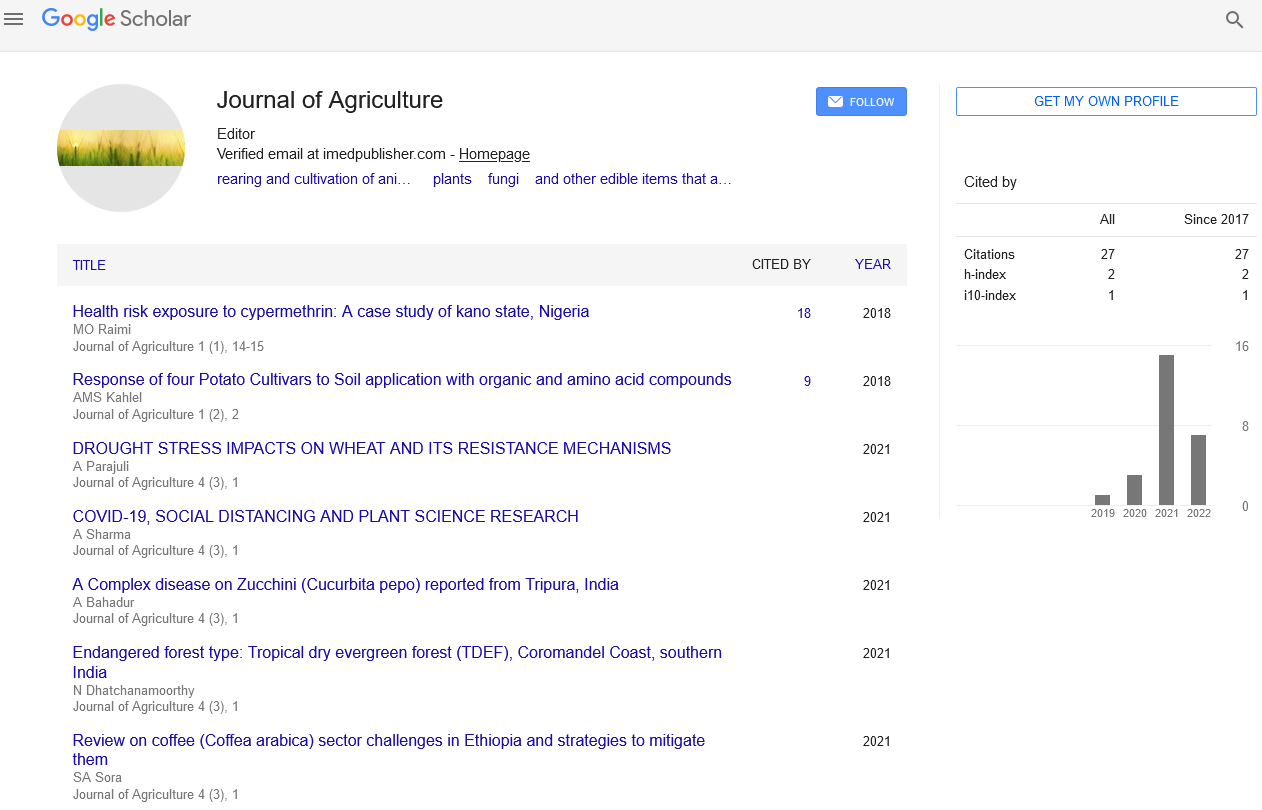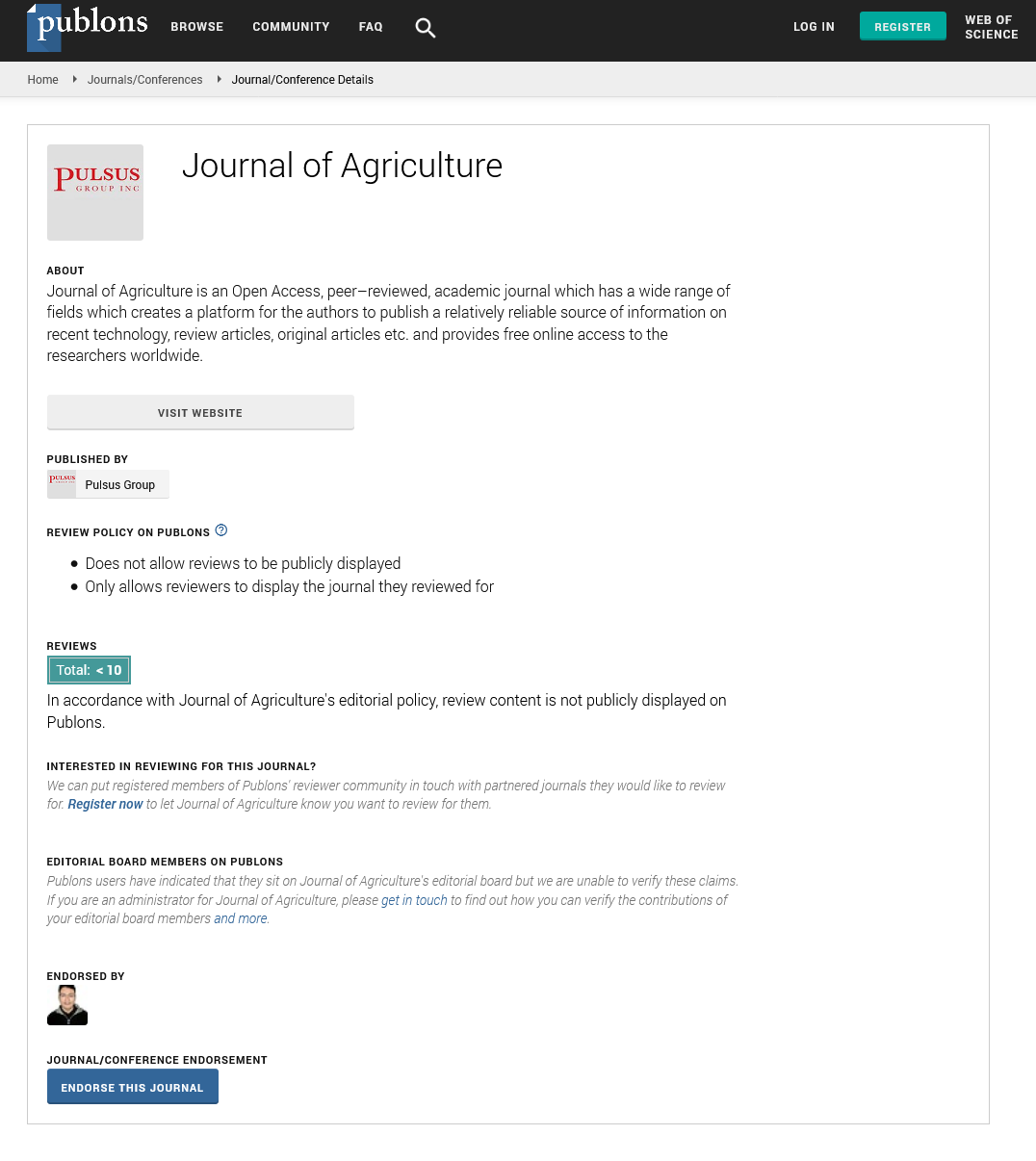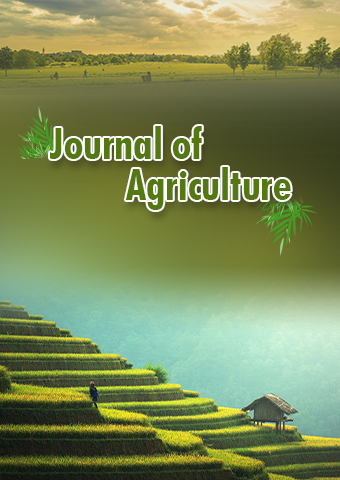Editorial - Journal of Agriculture (2023) Volume 6, Issue 4
Effects of organic, metallic, and metallic oxide nanoparticles on plant physiology
Keelin Reilly*
Department of Geographic Information and Tourism, Chuzhou University, China
Department of Geographic Information and Tourism, Chuzhou University, China
E-mail: Keelinreily6@gmail.com
Received: 01-Aug -2023, Manuscript No. jagri-23- 108483; Editor assigned: 03- Aug-2023, Pre-QC No. jagri-23-108483 (PQ); Reviewed: 17- Aug-2023, QC No. jagri-23-108483; Revised: 22-Aug-2023, Manuscript No. jagri-23- 108483 (R); Published: 29- Aug-2023; DOI: 10.37532/ jagri.2023.6(4).88-90
Abstract
Nanotechnology is a research area that has experienced tremendous development given the enormous potential of nanoparticles (NPs) to influence almost all industries and conventional processes. NPs have been extensively used in agriculture to improve plant physiology, production, and nutritional values of plant-based products. The large surface area and small size are some of the desired attributes for NPs that can substantially ameliorate plants’ physiological processes, thereby improving crop production. Nevertheless, the results derived from such research have not always been positive as NPs have been shown, in some cases, to negatively affect plants due to their potentially toxic nature. These toxic effects depend upon the size, concentration, nature, zeta potential, and shape of nanoparticles, as well as the used plant species. The most common response of plants under c is the activation of antioxidant systems and the production of secondary metabolites. The mitigation of such NPsinduced stress highly varies depending on the amount of NPs applied to the plant growth stage and the environmental conditions. On the contrary, higher photosynthetic rates, higher chlorophyll, and praline content, improved homeostasis, hormonal balance, and nutrient assimilation are the favourable physiological changes after NPs applications. Alternatively, NPs do not always exhibit positive or negative impacts on plants, and no physiological influences are sometimes observed. Considering such diversity of responses after the use of NPs on plants, this review summarizes the progress made in nanotechnology on the influence of different NPs in plant physiology through the use of indexes like seed germination, root and shoot morphology, photosynthesis, and their impact when used as carriers of cell signalling molecules such as nitric oxide (NO). Understanding the intimate dynamics of nanoparticle toxicity in plants can prove to be fruitful for the development of areas like agronomy, horticulture, plant pathology, plant physiology, etc. That, in return, can assist to ensure agricultural sustainability. Similarly, this may also help to pave the way to combat the drastic climate change and satisfy growing food demands for the ever-increasing world population. Further studies on molecular and genetic levels can certainly broaden the current understanding of NPs-plant interactions and devise the respective mitigation strategies for environmental safety.
Keywords
Plant physiology • Nanotechnology • Photosynthetic • Nanotechnology • Molecular and genetic levels
Introduction
Nanotechnology, early coined in the 1970s is a field of science dealing with the synthesis and development of a variety of nanomaterials with the purpose to use them for the improvement of, among others, human wellness. Nanotechnology is based on the construction of materials at the nanoscale dimension. Such manipulations at the nanoscale level result in novel chemical, physical and biological products [1]. Thus, nanotechnology, which has emerged as a centre of consideration in the current era of science, technology, and innovation, deals with interdisciplinary research including a wide spectrum of scientific and technological disciplines such as Chemistry, Material Sciences, Medicine, Physics, Engineering, and Biotechnology. The core building blocks of nanotechnology are nanoparticles (NPs) [2]. The term NP is used to describe particles that vary in size from 1 to 100 nm and they are considered as the spearheads of the exponentially growing nanotechnology discipline. Due to their small size and large surface, the characterization and formulation of nanometallic particles have become the centre of examination as it offers improved applications and enhanced properties The Agriculture sector currently faces challenging threats i.e., climate change, plant diseases, water scarcity, that might influence crop yields and food security [3]. The application of NPs has the potential to correct some unwanted practices like overuse of fertilization and synthetic plant growth promoters, and other inadequately used resources, thereby promoting crop growth and yield. Thus, the use of various metallic NPs has been reported to increase the redox potential, praline, and chlorophyll contents, and to improve photosynthesis, stress tolerance, and mineral nutrition. But also, the use of NPs to deliver nitric oxide (NO) to specific plant targets could be a strategy to influence some physiological processes, such as germination, fruit ripening, and response to stress (both biotic and abiotic) where NO has been reported to be involved. On the contrary, it is important to consider the sinking of NPs into the soil that may have a toxic impact on plants due to their similarity to heavy metals. It is therefore imperative to consider the negative impact of NPs on plants, the environment, and, subsequently, on humans [4].
Gold nanoparticles
There are limited studies available about the effect and interaction of Au-NPs in higher plants Some reports indicate an enhancement in seed germination with Au-NPs in species such Brassica juncea, Boswellia ovalifoliolata, Gloriosa superba, and Arabidopsis thaliana Shah and Belozerova (2009) reported that low concentrations of Au-NPs and a combination of Cu-NPs and Au-NPs positively influenced the germination of lettuce (Lactuca sativa) seeds. Similarly, Au- NPs produced through green synthesis from the Terminalia Arjuna fruit extract also enhanced seed germination of flame lily (G. superba), an endangered medicinal plant. A novel approach of NPs application was investigated to find the possible effects on the seed germination by applying the electrospray technique to bombard Au-NPs on lettuce and grass seeds either under stress conditions (e.g., low pH medium) or for aged seeds. Documented no inhibitory effects of Au-NPs when they investigated Au-NPs, Cu-NPs, and Ag-NPs against seed germination frequency of E. sativa, and likewise, Au-NPs did not affect seed germination when tested against barley seeds.also investigated the effects of Au- NPs, Cu-NPs, and Ag-NPs on A [5]. absinthium seed germination, and it was found that Au-NPs negatively affect seed germination.
Multi-walled carbon nanotube
Explored the influence MWCNT on seed germination of six plant species including cucumber, radish, corn, lettuce, rape, and ryegrass, and no adverse effects were observed. These authors also reported no significant influence on the germination of radish by applying other nanoparticles harboring Al, Al2O3, Zn, and No. However, MWCNTs have been reported to act as regulators for seed germination. Likewise, Mondal et al. (2011) also reported increased germination and growth of brown mustard when MWCNTs of approximately 30 nm diameter were applied. Conversely, MWCNTs were found to inhibit the rice seed germination [6].
Impact of NPs on root and shoot growth of plants
The U.S. Environmental Protection Agency has suggested seed germination and root elongation as two standard phytotoxic indicators, and insensitivity of seed germination to NPs has been documented in several research articles. Both types of NPs effects, regulatory and inhibitory, on plant growth have been recognized. The general mechanism of the NPs transport in plants is via roots, which is further facilitated by the vascular system into the plant shoots depending upon physiological characteristics of NPs and plant anatomy. NPs can cause various phytotoxic phenotypes in seedlings including reduced biomass, stunt growth, and root cap deformity. It is mandatory to consider that plant growth inhibition may not be directly linked to nanoparticles’ phytotoxicity. Rather, the physical interactions between plant cell transport pathways and nanoparticles may result in toxicity i.e., by inhibiting the symplastic connections between cells through blockage of the nano-sized plasmodesmata or trafficking by blockage of the intercellular spaces in the cell wall or the cell wall pores [7]. The solvent effect is another factor that needs to be considered in phytotoxicity studies, but the synergistic effects of stabilizers and NPs should be taken also into consideration. Additionally, specific surface area and particle size have been tagged as more appropriate phytotoxicity indicators.
Regulation of hormonal balance
Phytohormones are critical for prominent physiological changes i.e., germination, growth, abscission, senescence, sex expression, flowering, fruit setting, etc. Additionally, they also help plants to face stressful conditions. A proper hormonal balance can efficiently contribute towards improved crop production and yield. Various studies have been undertaken during the past decade, using NPs, to achieve this objective. However, there is still a need to establish a proper interaction mechanism of NPs in regulating phytohormones [8]. Thus, downregulation of genes responsible for gibberellic acid, ethylene, cytokinins, auxins, and abscisic acid (ABA) response in rice callus was reported when Ag-NPs were used. Likewise, Ag-NPs increased the concentrations of indole-3-acetic acid, gibberellin GA3, and total cytokinins, whereas the concentration of abscisic acid decreased. Interestingly, in another study, the use of phytohormones against the NPs toxicity was reported where CuO-NPs toxicity was modulated by the use of indole-3-acetic acid (IAA) on Possum stadium (Ochoa et al., 2017). This could be a good stress mitigation strategy but it would overrule the objective of the use of NPs for better crop production if they provoke toxic effects in the first place and then necessitate the use of phytohormones to neutralize their unpleasant effects. CuO-NPs also induced substantial alteration in the IAA and ABA concentrations when applied to cotton and Btcotton crops [9, 10].
Conclusion
Organic, metallic, and metallic oxide nanoparticles have shown considerable potential in improving plant physiology and agricultural practices. However, the deployment of these nanoparticles in farming requires careful consideration of their potential ecological impacts. Researchers and policymakers must conduct further studies to understand the long-term consequences of nanoparticle application, including their interactions with soil microorganisms, potential leaching into groundwater, and bioaccumulation in plants and animals. By doing so, we can harness the benefits of nanotechnology in agriculture while ensuring sustainable and environmentally friendly practices.
References
- Ahmad A, Hashmi SS, Palma JM et al. Influence of metallic, metallic oxide, and organic nanoparticles on plant physiology.Chemosphere.290, 133329 (2022).
- Meng J, Wang J, Rui M et al. OsFTIP7 determines metallic oxide nanoparticles response and tolerance by regulating auxin biosynthesis in rice.JHazardMater. 403 (5), 123946 (2021).
- Scott J, Jason C, Stephen D. Zinc, copper, or cerium accumulation from metal oxide nanoparticles or ions in sweet potato: yield effects and projected dietary intake from consumption.Plant PhysiolBiochem. 110,128-137(2017).
- Landa L, Premysl N. Positive effects of metallic nanoparticles on plants: Overview of involved mechanisms.Plant PhysiolBiochem. 161, 12-24(2021).
- Dali W, Lin Z, Wang T et al. Where does the toxicity of metal oxide nanoparticles come from: the nanoparticles, the ions, or a combination of both?.J Hazard Mater.308,328-334(2016).
- Afzal S, Singh NK. Effect of zinc and iron oxide nanoparticles on plant physiology, seed quality and microbial community structure in a rice-soil-microbial ecosystem.EnvironPollut.314 (4), 120224(2022).
- Kiran P, Adi J. Aquaculture role in global food security with nutritional value: a review.TranslAnimSci. 3(2), 903-910 (2019).
- Harris P, Gupta H, Bhagat R et al. Effects of different metal oxide nanoparticles on plant growth. Recent Advances and Impacts. 259-282(2021).
- Zabrieski Z, Morrell E, Hortin J et al. Pesticidal activity of metal oxide nanoparticles on plant pathogenic isolates of Pythium.Ecotoxicology.24 (6), 1305-1314(2015).
- Shah J, Ali A. Combined effect of Bacillus fortis IAGS 223 and zinc oxide nanoparticles to alleviate cadmium phytotoxicity in Cucumis melo. Plant PhysiolBiochem. 158, 1-12(2021).
Indexed at Google scholar Cross ref
Indexed at Google scholar Cross ref
Indexed at Google scholar Cross ref
Indexed at Google scholar Cross ref
Indexed at Google scholar Cross ref
Indexed at Google scholar Cross ref
Indexed at, Google Scholar, Crossref
Indexed at, Google Scholar, Crossref


